Catholic Church in Bosnia and Herzegovina
The Catholic Church in Bosnia and Herzegovina is part of the worldwide Catholic Church under the spiritual leadership of the pope in Rome.
According to the latest census from 2013, there are 544,114 Catholics in Bosnia and Herzegovina, making 15.41% of the population.
History
Antiquity
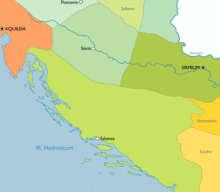
Christianity arrived in Bosnia and Herzegovina during the first century AD. Saint Paul wrote in his Epistle to the Romans that he brought the Gospel of Christ to Illyria. Saint Jerome, a Doctor of the Church born in Stridon (modern-day Šuica, Bosnia and Herzegovina), also wrote that St. Paul preached in Illyria. It is believed that Christianity arrived with Paul's disciples or Paul himself.[1]
After the Edict of Milan, Christianity spread rapidly. Christians and bishops from the area of present-day Bosnia and Herzegovina settled around two metropolitan seats, Salona and Sirmium. Several early Christian dioceses developed in the fourth, fifth and sixth century. Andrija, Bishop of Bistue (episcopus Bestoensis), was mentioned at synods in Salona in 530 and 533. Bishop Andrija probably had a seat in the Roman municipium Bistue Nova, near Zenica. The synod in Salona decided to create the new diocese of Bistue Vetus), separating it from the Diocese of Bistue Nova. Several dioceses also were established in the south at Martari (present-day Konjic), Sarsenterum, Delminium, Baloie and Lausinium.[1]
With the collapse of the Western Roman Empire in 476 and with the ravaging and the settling of Avar and Slavic tribes, this church organization was completely destroyed.
Medieval era
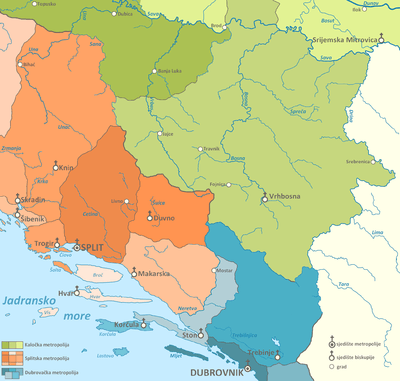
After the arrival of the Croats on the Adriatic coast in the early seventh century, Frankish and Byzantine rulers began baptizing them as far inland as the river Drina. Christianization was also influenced by the proximity of old Roman cities in Dalmatia and spread from the Dalmatian coast towards the interior of the Duchy of Croatia. This area was governed by the archbishops of Split, successors of Salona's archbishops, who attempted to restore the ancient Duvno Diocese. Northern Bosnia was part of the Pannonian-Moravian archbishopric, established in 869 by Saint Methodius of Thessaloniki.[2]
Diocese of Trebinje was the first diocese on this area established in the Middle Age. It is mentioned for the first time in the second half of the 10th century during the pontificate of Pope Gregory V.[3]
The Diocese of Bosnia was established in the 11th century. Based on Provinciale Vetus, a collection of historical documents published in 1188, it is first mentioned as subordinate to the Archdiocese of Split and a second time as part of the Archdiocese of Ragusa. The Diocese presumably originated between 1060 and 1075.[4]
Ottoman era
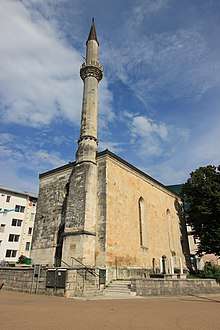
Bosnia and Herzegovina, split between the kingdoms of Croatia and Bosnia, came under Ottoman rule during the 15th and 16th centuries. Christian subjects of the Ottoman Empire had "protected person" or "people of the dhimma" status, which guaranteed them their possessions and works in agriculture, crafts and trade if they remained loyal to the Ottoman government. Christians were not allowed to protest against Islam, build churches or establish new church institutions. Public and civil service were performed by Muslims.[5]
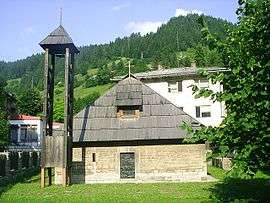
The Eastern Orthodox Church enjoyed a better position in the Ottoman Empire than other religions. Since the pope was a political opponent of the empire, Catholics were subordinate to the Orthodox. Unlike the Orthodox metropolitans and bishops, Catholic bishops were not recognized as ecclesiastical dignitaries. The Ottoman government recognized only some Catholic communities, particularly in larger cities with a strong Catholic commercial population. The authorities issued them ahidnâmes, identity documents guaranteeing them freedom of movement (for priests), religious rituals, property and exemption from taxes for those receiving charity. Mehmed the Conqueror issued two such documents to the Bosnian Franciscans—the first after the conquest of Srebrenica in 1462, and the second during the military campaign in the Kingdom of Bosnia in 1463. The latter, released in the Ottoman military camp at Milodraž (on a road connecting Visoko and Fojnica), was known as the Ahdname of Milodraž or Ahdname of Fojnica. The terms of the guarantee were often not implemented; Orthodox clergy attempted to transfer part of their tax obligation to Catholics, leading to disputes between the Orthodox clergy and Franciscans in the Ottoman courts.[5]
The number of Catholics in Bosnia under the Ottoman rule is unknown. Based on travel literature, it is believed that in the first half of the 16th century the Catholic population still constituted a majority. Serbs who came from the east were also identified as Catholic, and Turkish soldiers primarily constituted the Islamic population. According to Apostolic visitor Peter Masarechi, in 1624 Catholics made up about a quarter of the population and Muslims the majority. During the 17th century Catholics fell to third place in the population of Bosnia and Herzegovina, where they remain today.[5]
Restoration of church hierarchy
After Bosnia Vilayet came under the Austro-Hungarian rule in 1878, Pope Leo XIII restored the vilayet's church hierarchy. In Ex hac augusta, his 5 July 1881 apostolic letter, Leo established a four-diocese ecclesiastical province in Bosnia and Herzegovina and abolished the previous apostolic vicariates. Sarajevo, formerly Vrhbosna, became the archdiocesan and metropolitan seat. Its suffragan dioceses became the new dioceses of Banja Luka and Mostar and the existing Diocese of Trebinje-Mrkan. Since the former Diocese of Duvno is within the Diocese of Mostar, the bishop of Mostar received the title of bishop of Mostar-Duvno to commemorate it.[7] Although a cathedral chapter was immediately established in Vrhbosna, additional time was allowed for its establishment in other dioceses.,[7] In a March 1881 letter to Viennese nuncio Serafino Vannutelli, Josip Juraj Strossmayer, bishop of Bosnia or Ðakovo and Srijem wrote that the establishment of new dioceses was required; however, he opposed a metropolitan seat in Bosnia because it would not be affiliated with the Catholic Church in Croatia.[2]
Austro-Hungarian rule
In negotiations between the Holy See and Austro-Hungary, the Emperor of Austria had the last word in the appointment of bishops. Diocesan clergy and The Franciscans (some of the only clergy in Bosnia and Herzegovina during the Ottoman era) were in place. Josip Stadler, professor of theology at University of Zagreb, was appointed archbishop of Vrhbosna and the dioceses of Mostar and Banja Luka were entrusted to Franciscans Paškal Buconjić and Marijan Marković. To protect the diocesan priests, Stadler asked the Holy See to remove the Franciscans from all parishes. The Holy See ruled that in 1883, the Franciscans had to transfer part of their parishes to the archbishop; by the end of the century, about one-third of the former Franciscan parishes were held by local bishops. The archbishop sought several more parishes, which created tensions.[5]
Under Austro-Hungarian rule the number of Catholics increased by about 230,000, largely due to immigration from elsewhere in the empire. The total number of immigrants was about 135,000, of which 95,000 were Catholic. One-third of the immigrant Catholics were Croatian, and 60,000 were Czechs, Slovaks, Poles, Hungarians, Germans and Slovenians.[5]
Interwar period
The Kingdom of Yugoslavia was formed on 1 December 1918 from the State of Slovenes, Croats and Serbs, itself formed from the merger of Austro-Hungarian Empire territories with the formerly-independent Kingdom of Serbia. Although Catholic opinion was divided in Bosnia and Herzegovina about the union with Serbia after the unification Catholic bishops (including Stadler) encouraged priests and the laity to be loyal to the new government. In their view, in the new state Croats would have national rights and the Church would be free. When this did not happen, relations between church and state cooled and the clergy resisted the government.[8]
Ivan Šarić was expected to be appointed Stadler's successor after his death, but the Belgrade government and Franciscans in Bosnia opposed him because of his similarity to Stadler. On 2 May 1922, Šarić was appointed archbishop of Vrhbosna.[8]
Under communism
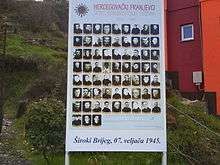
The ideological conflict between Christianity and Marxist philosophy in Bosnia and Herzegovina during the Second World War and the era of communist Yugoslavia hardened into confrontation between the communist movement and the Catholic Church. Under the direction of the Yugoslav Communist Party, 184 clergy were killed during and after the war, including 136 priests, 39 seminarians and four brothers; five priests died in communist prisons. Worst affected were the Franciscan provinces of Herzegovina and Bosna Srebrena, whose 121 friars were killed.[9] During the February 1945 Partisan liberation of Mostar and Široki Brijeg, 30 friars from the convent in Široki Brijeg (including 12 professors and the principal of a Franciscan grammar school) were killed.[10]
Persecution of priests, laity and the church became organized after the war, with books published linking the Catholic Church with the fascist Ustaše regime and the Western powers to justify the persecution. The communists ignored the collaboration of 75 Catholic priests with the Yugoslav Partisans.[11]
Faced with hostility from the Yugoslav communist authorities after the Second World War, the bishops met in Zagreb and issued a pastoral letter from the Catholic bishops of Yugoslavia on 20 September 1945 protesting injustice, crimes, trials and executions. They protected innocent priests and laity, noting that they did not want to defend the guilty; the number truly guilty was believed small.
We accept that there were some priests, who - seduced by the national party passion - violated the sacred law of Christian justice and love, and who therefore deserve to be tried in the court of terrestrial justice. We must however point out that the number of such priests is more than negligible, and that the serious allegations which have been presented in the press and in the meetings against a large part of the Catholic clergy in Yugoslavia, have to be included within tendentious attempts to deceive the public aware of the lies, and take away the reputation of the Catholic Church ...[9]
The earthquake that struck the Banja Luka area in October 1969 significantly damaged Banja Luka Cathedral, which had to be demolished. In 1972 and 1973 the present, modern tent-shaped cathedral was built on its site.[12]
Bosnian War
In August 1991, when war in Croatia had begun and was beginning in Bosnia and Herzegovina, Archbishop Puljić and Bishops Komarica and Žanić appealed to the authorities, religious communities and the international community to preserve Bosnia and Herzegovina as a state and prevent war. However, bishops differed about the internal organization of Bosnia and Herzegovina. Žanić believed that each ethnic group should have a separate administrative unit within the country, but Puljić and the leadership of the Franciscan Province of Bosnia Srebrena insisted on a single state without divisions. In 1994, the bishops demanded that the rights of all peoples must be ensured in all areas of the country. They opposed dividing Bosnia and Herzegovina into states because Catholic religious, sacred and cultural objects would remain largely outside the area granted to the Croats. They also feared the destruction of established diocesan borders of dioceses, which would have political consequences.[13]
Throughout Bosnia, Catholic churches were destroyed by Muslim and Serb armed forces. According to some sources, it is estimated that the total number of completely destroyed Catholic structures is 188, 162 severely damaged and 230 damaged. Of these figures, 86 per cent of these "completely destroyed" were attributed to Serb forces and 14 per cent to Muslim fores, of the "severely damaged" 69 per cent were attributed to Serb forces and 31 per cent to Muslim forces, while in the "damaged" category 60 per cent was attributed to Serb forces and 40 per cent to Muslim forces.[14] But numbers could be much larger, as given in table below.
| Destroyed by Muslim extremists | Destroyed by Serb extremists | Damaged by Muslim extremists | Damaged by Serb extremists | Total destroyed during the war | Total damaged during the war | Total | ||||||||
|---|---|---|---|---|---|---|---|---|---|---|---|---|---|---|
| churches | 8 | 117 | 67 | 120 | 125 | 187 | 312 | |||||||
| chapels | 19 | 44 | 75 | 89 | 63 | 164 | 227 | |||||||
| clergy houses | 9 | 56 | 40 | 121 | 65 | 161 | 226 | |||||||
| monasteries | 0 | 8 | 7 | 15 | 8 | 22 | 30 | |||||||
| cemeteries | 8 | 0 | 61 | 95 | 8 | 156 | 164 | |||||||
| Total | 44 | 225 | 250 | 481 | 269 | 731 | 1000 | |||||||
Modern history
Pope John Paul II's 23 June 2003 visit to Banja Luka and Bosnia-Herzegovina helped draw the attention of Catholics worldwide to the need to reconstruct the church in the country;[16] the destruction of churches and chapels was one of the most visible wounds of the 1992-95 war. In the Diocese of Banja Luka alone, 39 churches were destroyed and 22 severely damaged. Nine chapels were destroyed and 14 damaged; two convents were destroyed and one severely damaged, as were 33 cemeteries.[16]
In 2009 the remains of friar Maksimilijan Jurčić, killed by partisans on 28 January 1945, were discovered and buried in Široki Brijeg.[17][18] Among those in attendance at his funeral were Ljubo Jurčić (the friar's nephew) and the Croatian consul-general in Mostar, Velimir Pleša.[19]
Hierarchy
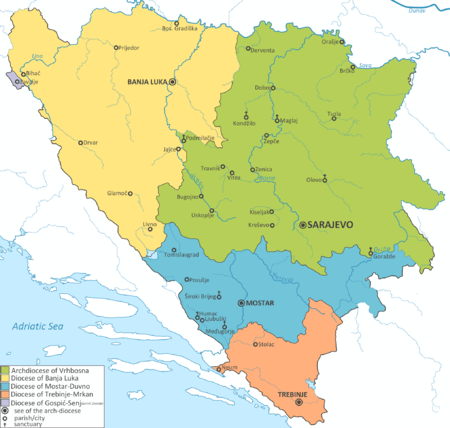
The Church in Bosnia and Herzegovina has one province: Sarajevo. There are one archdiocese and 3 dioceses, which are divided into archdeaconries, deaneries and parishes.
| Province | Diocese | Approximate territory | Cathedral | Creation |
|---|---|---|---|---|
| Sarajevo | ||||
| Archdiocese of Vrhbosna Archidioecesis Vrhbosnensis o Seraiensis | Central Bosnia, Semberija, Posavina, Podrinje | Sacred Heart Cathedral | 11th century (originally as Diocese of Bosnia, elevated to Archdiocese 1881) | |
| Diocese of Banja Luka Dioecesis Banialucensis | Bosanska Krajina, Tropolje, Donji Krajevi, Pounje | Cathedral of Saint Bonaventure | 5 July 1881 | |
| Diocese of Mostar-Duvno Dioecesis Mandentriensis-Dulminiensis | Herzegovina, Gornje Podrinje | Cathedral of Mary, Mother of the Church | 6th century (originally as Diocese of Duvno) | |
| Diocese of Trebinje-Mrkan Dioecesis Tribuniensis-Marcanensis | South and East Herzegovina | Cathedral of the Birth of Mary | 984 | |
| - | Military Ordinariate of Bosnia and Herzegovina Ordinariatus Militaris in Bosnia et Herzegovina | Bosnia and Herzegovina | 1 February 2011 |
The Zavalje parish of the Diocese of Gospić-Senj is in Bosnia and Herzegovina. There are two Franciscan provinces in the country: the Franciscan Province of the Assumption of the Blessed Virgin Mary, based in Mostar, and the Franciscan Province of Bosna Srebrena, based in Sarajevo.
Attitudes
According to a Pew Research poll from 2017, Catholics in Bosnia and Herzegovina are predominantly supportive of Church's stances on moral and social issues. 54% of respondents attend mass, 58% believe the Church's stance on contraception should not change, 69% support the Church's stance on ordination of women, 71% think abortion should be illegal in most cases, 83% practice fasting on certain days and 90% support the Church's stance on same-sex marriage.[20]
Shrines
_Medjugorje_-_Hotel_Pansion_Porta_-_Bosnia_Herzegovina_-_Creative_Commons_by_gnuckx_(4694635177).jpg)
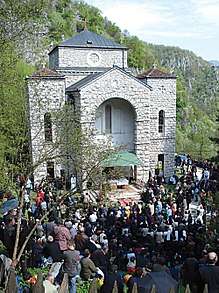
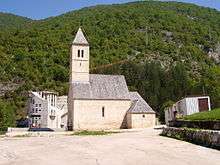
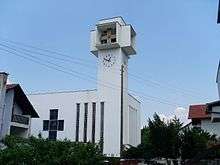
Queen of Peace, Medjugorje
Medjugorje, a village in Herzegovina and a parish in the Diocese of Mostar-Duvno, has been the site of alleged apparitions of the Virgin Mary since 24 June 1981. It soon became a place of pilgrimage for individuals and prayer groups. The phenomenon is not officially recognized by the Catholic Church.[21][22] The Holy See announced in March 2010 that it had established a commission under the auspices of the Congregation for the Doctrine of the Faith, headed by Cardinal Camillo Ruini, to evaluate the apparitions.[23]
Our Lady of Olovo
The Church of the Assumption in Olovo is a Marian pilgrimage site, and its Shrine of Our Lady is well known in southeast Europe. According to a 1679 record, it was visited by pilgrims from Bosnia, Bulgaria, Serbia, Albania and Croatia. It is most popular on the 15 August feast of the Assumption. There are two paintings of Mary at the shrine. Until 1920, the 18th-century S. Maria Plumbensis was held by the Franciscans in Ilok; later held in Petrićevac and Sarajevo, in 1964 it was moved to Olovo. A 1954 painting by Gabriel Jurkić was based on a description of the older painting, whose whereabouts were unknown at the time.
Saint John the Baptist, Podmilačje
The Shrine of St. John the Baptist in Podmilačje is one of the oldest shrines in Bosnia and Herzegovina. The village of Podmilačje, 10 kilometers from Jajce, was first mentioned in a 1461 document by King Stjepan Tomašević; at the time, the church had probably recently been built. It is the only medieval church in Bosnia which remained a church.
Shrine of Saint Leopold Mandić in Maglaj
Maglaj is a town in central Bosnia in the Bosna Valley near Doboj. It was first mentioned on the 16 September 1408 in the charter (sub castro nostro Maglay) of the Hungarian King Sigismund. The parish of Maglaj was restored in 1970, and a rectory was built. In autumn 1976 the dilapidated St. Anthony Church, built in 1919, was demolished. Construction of a new church and shrine to St. Leopold Mandić began the following spring, and its foundations were blessed on 15 May. On 17 June 1979, the shrine of St. Leopold Bogdan Mandić in Maglaj was dedicated.
Apostolic Nunciature
The Apostolic Nunciature to Bosnia and Herzegovina is an ecclesiastical office of the Catholic Church in Bosnia and Herzegovina. The office of the nunciature has been located in Sarajevo since 1993. The first Apostolic Nuncio to Bosnia and Herzegovina was Francesco Monterisi, who served from June 1993 to March 1998. The current nuncio is His Most Reverend Excellency Luigi Pezzuto, who was appointed by Pope Benedict XVI on 17 November 2012.[24]
See also
References
- 1 2 Catholic Encyclopedia:Bosnia and Herzegovina
- 1 2 Šanjek, Franjo (1996). Kršćanstvo na hrvatskom prostoru [Christianity in the Croatian regions] (in Croatian). Zagreb: Kršaćnska sadašnjost.
|access-date=requires|url=(help) - ↑ "Biskupia trebinjsko-mrkanska". md-tm.ba/. Diocese of Mostar-Duvno and Trebinje-Mrkan. Retrieved 4 August 2017.
- ↑ OŠJ 1975, p. 134.
- 1 2 3 4 5 Vasilj, Snježana; Džaja, Srećko; Karamatić, Marko; Vukšić, Tomo (1997). Katoličanstvo u Bosni i Hercegovini [Catholicism in Bosnia and Herzegovina] (in Croatian). Sarajevo: HKD Napredak.
|access-date=requires|url=(help) - ↑ "Stara crkva". zupavares.com. Vareš Parish. Retrieved 7 May 2016.
- 1 2 Leo XIII, Ex hac augusta
- 1 2 Goluža, Božo (1995). Katolička Crkva u Bosni i Hercegovini 1918.-1941. Mostar: Teološki institut Mostar.
|access-date=requires|url=(help) - 1 2 Lučić, Ivan (20 November 2011). "Progon Katoličke Crkve u Bosni i Hercegovini u vrijeme komunističke vlasti (1945–1990)". Croatica Christiana Periodica. 36: 105–144. Retrieved 6 May 2016.
- ↑ Pandžić, Bazilije (2001). Hercegovački franjevci sedam stoljeća s narodom [Herzegovinian franciscans seven centuries with people] (in Croatian). Mostar-Zagreb: Ziral.
|access-date=requires|url=(help) - ↑ Petešić, Ćiril (1982). Katoličko svećenstvo u NOB-u 1941–1945 [Catholic clergy in National liberation movement] (in Croatian). Zagreb: VPA.
|access-date=requires|url=(help) - ↑ "Župa Banja Luka". biskupija-banjaluka.org. Diocese of Banja Luka. Retrieved 6 May 2016.
- ↑ Krišto, Jure (June 2015). "Katolička Crkva u Bosni i Hercegovini (1991–1995)". Croatica Christiana Periodica. 39: 197–227. Retrieved 14 May 2016.
- ↑ Walasek, Helen (2015). Bosnia and the Destruction of Cultural Heritage. New York: Routledge. p. 153.
|access-date=requires|url=(help) - ↑ Destroyed and damaged Catholic churches and religious buildings in Bosnia and Herzegovina in war 1991 - 1995 (original title: Srušene i oštećene katoličke crkve i vjerski objekti u Bosni i Hercegovini u ratu 1991. - 1995), Slobodan Praljak, page 39, 2009
- 1 2 Pope's Trip Helped Highlight the Plight Archived 2010-12-04 at the Wayback Machine.
- ↑ Široki Brijeg: Pokopani posmrtni ostaci fra Maksimilijana Jurčića Archived 2009-12-02 at the Wayback Machine.
- ↑ Misa za 66 ubijenih hercegovačkih franjevaca, Catholic Press Agency Zagreb
- ↑ FRA MAKSIMILIJAN POKOPAN CRKVI UZNESENJA BL. DJEVICE MARIJE Archived 2010-04-19 at the Wayback Machine.
- ↑ http://assets.pewresearch.org/wp-content/uploads/sites/11/2017/05/09154356/Central-and-Eastern-Europe-Topline_FINAL-FOR-PUBLICATION.pdf
- ↑ "Vatican Probes Claims of Apparitions at Medugorje". Reuters. Retrieved 14 May 2013.
- ↑ Pope finally launches crackdown on world's largest illicit Catholic shrine and suspends 'dubious' priest. (Sep 3, 2008). Caldwell, Simon. Mail Online. Retrieved Feb 28, 2010.
- ↑ "Holy See confirms creation of Medjugorje Commission". Catholic News Agency (ACI Prensa). March 17, 2010.
- ↑ "Apostolic Nunciature Bosnia and Herzegovina". gcatholic.org. GCatholic. Retrieved 18 May 2013.
External links
